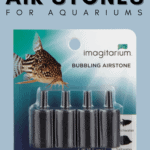While it’s fun to learn about the newest high-tech aquarium equipment, sometimes it’s the oldest and simplest devices that stand the test of time. One of the most useful tools for keeping your aquarium healthy is a simple fish tank air bubbler. Let’s talk about what they bring to the game and how to pick the best air stone for any tank!
Quick Comparisons Of The 5 Best Air Stones For Aquariums
| IMAGE | BRAND | DETAILS | |
|---|---|---|---|
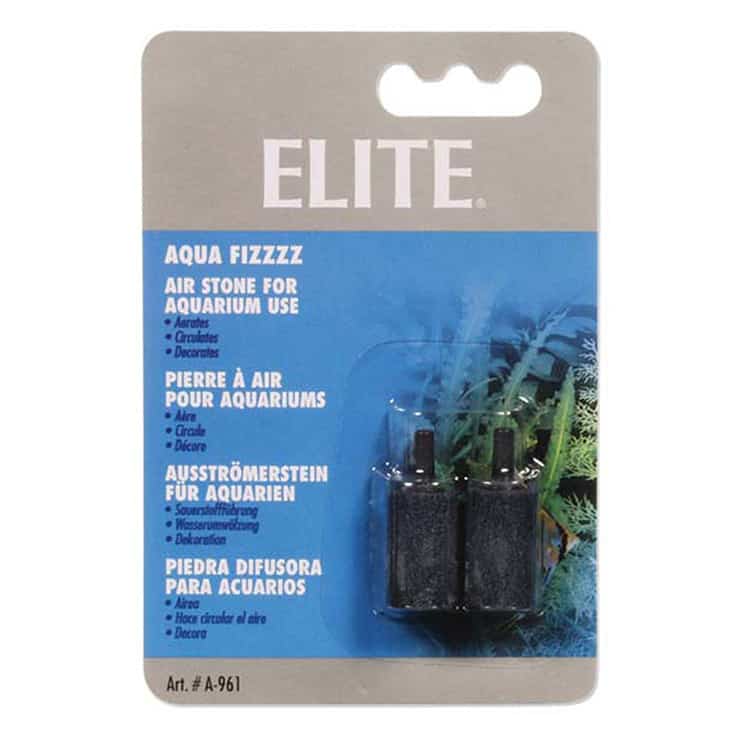 | Aqua Fizzzz Cylinder Air Stone |
| View Product |
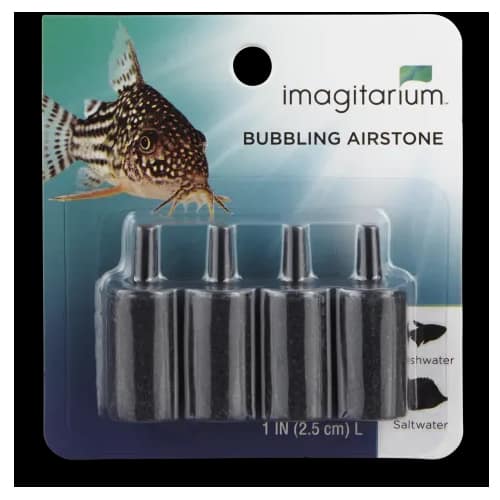 | Imagitarium Bubbling Airstone |
| View Product |
 | Hygger Aquarium Air Stone Kit |
| View Product |
 | Aqueon Bubble Wand |
| View Product |
 | JZMYXA Air Stones |
| View Product |
What Is An Air Stone, And How Does It Work?

Aquarium bubble stones and fish tank aerators do more than just add interest and fun to your set-up. They also help the circulation in your tank and increase the amount of oxygen (O2) in the water. Higher O2 levels increase the health of your aquarium plants, fish and invertebrates, and reduces their stress to boot!
Dead Zones, or areas of depleted oxygen, are a real problem for many aquariums. Having hypoxic zones in your tank can lead to a loss of fish and live plants, and can cause nasty algae outbreaks that are hard to treat. How do air stones work in fish tanks to prevent these issues?
- Air stones generate a constant stream of tiny bubbles when hooked into an electrical air pump.
- As these microbubbles float to the surface, the oxygen is diffused into the water, where aquatic animals and plants can use it.
- Bubblers and oxygen stones for fish tanks also create mild currents and help circulate the freshwater to every corner, reducing the potential for Dead Zones.
Here’s a tip on the use of the terms air stone vs airstone. While it’s technically correct to write it as one word, it may lead to confusion, because “airstone” is also the branded name of a building product unrelated to aquariums or fish keeping. Search for aquarium air stones and you should avoid getting the wrong products.
Benefits Of Using An Air Stone In Your Aquarium

Nearly any aquarium can benefit from having an air stone, regardless of the size or type of filtration equipment. Air stones are an inexpensive and easy way to ensure the water circulates around your entire tank, even areas to the sides of your filters. The bubbles maintain high oxygen levels, which is healthier overall.
Air stones and bubblers also add points of interest to your tank that draw the eye. They attract your active, schooling fish and strong swimmers like goldfish, tetras and freshwater sharks, who often like to play in the bubbles and current. Getting an air stone for your fish tank is one of the easiest ways to make it more attractive.
Are there any disadvantages to using these devices in your tank? Air stones do require a separate air pump and thin plastic tube to produce the bubbles, and in very small tanks this clutter might not be attractive. But it’s not hard to hide it under or behind other decor, and their benefits vastly outweigh their downsides.
Types Of Air Stones And Bubble Devices For Aquariums
Air stones and air diffusers (bubblers) are used in many industries besides the aquarium trade, so you’ll find a wide array of products when you run an internet search. But the best hydroponic air stone won’t necessarily be ideal for your aquarium, so look for bubblers made and manufactured specifically for fish tanks.

Regardless of the type, there’s a wide variety of air stones and diffusers that differ in their materials, construction quality and the size of the bubbles they produce. Some types are easier to maintain, while others last longer or produce smaller, finer bubbles that diffuse more oxygen into your water. Let’s take a look at your options!
Classic Air Stone
The old-school or classic air stone for fish tanks is exactly that: a small chunk of porous ceramic, rock or wood with a hole drilled into the center and a hollow connector that attaches to the air tubing. As air is forced down the tube, natural holes in the stone or woodblock produce a cascade of bubbles in your tank.
These air stones are often small, about an inch in length, and are ideal for aerating sump filters or protein skimmers on saltwater fish tanks. Many aquarists use these small stones in their box filters to increase the efficiency of their aquarium’s good bacteria or tuck them into the corners of their tank to prevent hypoxic zones.
Classic rock or wood air stones are easy to find, easy to use and inexpensive to replace, but they usually don’t last very long and can be hard to clean. Since they are made with natural materials, the bubbles may not be uniform in size. They’re not the most attractive air stones, but they’re ideal for Nano tanks and marine set-ups.
Flexible Bubble Walls
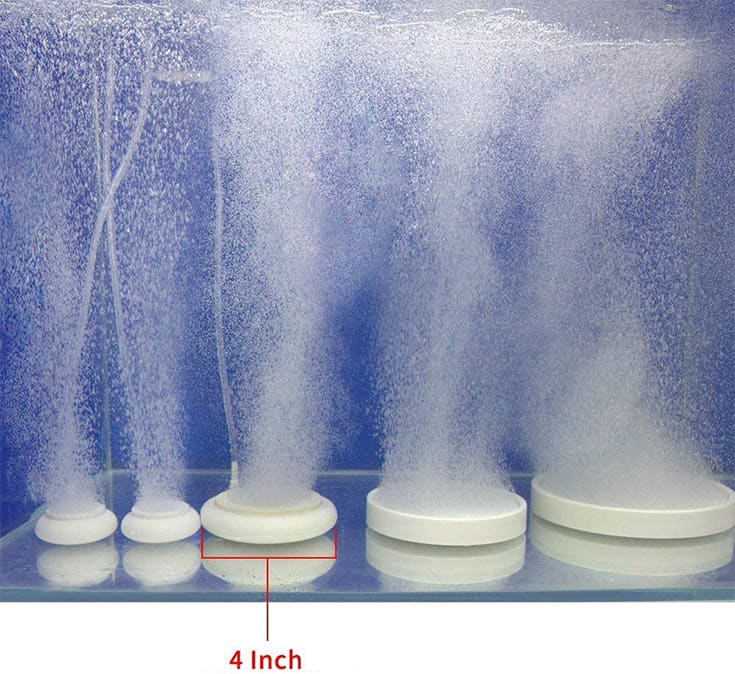
If you have a large tank or need a high level of efficiency in terms of oxygenating your water, then consider the flexible bubble wall diffusers. Usually made from a porous plastic tube similar to a hydroponic diffuser, these bubble walls can produce a steady stream of microbubbles.
Flexible bubblers allow you to wind the tube around your decor or create a circle of bubbles in the corner of your tank. The plastic bubble tubing usually lasts longer than natural stone or wood, and does a better job at making uniform, tiny bubbles. They come in a number of sizes and lengths, too.
Some bubble walls have a flexible frame to provide support and protection to the plastic bubble-tube, while budget versions usually come with just the unprotected bubble tube. It’s best to invest in a high-quality bubble wall that’s easy to clean, but you’ll still probably have to replace it every 6 months to once a year.
Bubble Wands
Similar to the flexible bubble walls, bubble wands are also a diffuser-style aerator. They have a simple rigid frame that holds the porous plastic bubble tubing in place and secures it to the side or back of your aquarium. They produce a nice stream of bubbles along the length of the wand once you hook up the air pump.
Bubble wands are usually less expensive than the flexible walls, and these are a popular option for large tanks because they are easy to hide at the back or behind other decor. They aren’t always the most efficient option, however. A cheap bubble wand may produce variable-sized bubbles rather than a steady stream of tiny ones.
A great way to use a bubble wand is to actually bury it under a thin layer of substrate, so the bubbles look like they are rising from your aquarium’s gravel. Even if you have to replace your bubble wand a few times a year, the bubbling substrate look is one of my favorites in an aquarium!
Bubbler Ornaments And Decorations
If you’re mostly focused on looks and not performance, then check out the bubbling ornaments and decorations. These devices are very attractive, and you can find them in a variety of styles and themes. I’ve seen ones that look like bubbling skulls or pirate chests, or you can go for the natural look with a bubbling flower, rock or log!
Bubbling ornaments usually do not produce a fine stream of microbubbles, and they are not as efficient as the styles above in terms of oxygenating your water. They’re really designed to look attractive rather than functioning as an important part of your aquarium’s circulation system. Your fish will still love them, though!
These are definitely some of the coolest options, but also tend to be more expensive as well. Some bubbler ornaments have other moving components or require additional electrical connections to operate. It just depends, since there’s so many diverse products that fall under this type of air stone.
Combination LED And Bubble Devices
The newest members of the air stone family meld air and LEDs for a stunning light and bubble show. They are basically bubbling wands or ornaments that also have a few colored or white diodes attached. These may be as simple as a bubble wand with a row of blue diodes or a full-on moving decoration with multiple colors!
As with the bubbling ornaments mentioned above, these combo bubblers are really designed for appearances rather than efficacy. They don’t produce the fine bubbles needed for the efficient absorption of oxygen. They’ll help with the circulation in your tank, but won’t add as much oxygen to the water as the other types.
Combo LED bubblers can also create a lot of clutter in a small tank, since they’ll need to be plugged into an outlet and air pump to operate. If the diodes burn out, you’ll probably have to replace the entire bubbler. Most do not have their own power switch as well, so the LEDs are always on unless you deliberately unplug it.
Type of Air Stone/Diffuser
Classic Air Stone
Advantages
- Inexpensive
- Easy to use
- Efficient at O2 delivery
- Ideal size for Nano Tanks and for hiding behind the decor
- Ideal for use inside box filters, sumps and protein skimmers
Disadvantages
- Limited size range and may need multiple stones/pumps for large tanks
- Not very attractive
- Time-consuming to clean
- Optimal performance lasts only 2 to 3 months
Type of Air Stone/Diffuser
Flexible Bubble Walls
Advantages
- Bends around decor for custom appearances
- Wide variety of sizes and lengths
- High-quality walls produce uniform bubbles for maximum oxygenation
Disadvantages
- Maybe more expensive than other types
- Some designs are hard to clean and maintain
- Rarely lasts longer than a year before requiring replacement
Type of Air Stone/Diffuser
Bubble Wands
Advantages
- Affordable for most
- Many different lengths available
- Easy to attach to the side or back of your tank
- Can often be buried under substrate for special effects
Disadvantages
- Quality and O2 efficiency varies considerably from brand to brand
- Often requires replacement every 3 to 6 months
- May be hard to clean
Type of Air Stone/Diffuser
Bubbler Ornaments
Advantages
- Highly attractive
- Easy to install and maintain
- Suitable for tanks of all sizes
- Wide variety of styles and themes available
- Usually lasts longer than other types
Disadvantages
- Designed for looks more than O2 delivery
- Decorative bubblers can be pricey
- Not very efficient and produces bubbles of all sizes
Type of Air Stone/Diffuser
Combo LED/Bubble Devices
Advantages
- Very attractive light and bubbler combo
- Easy to install
- LEDs are energy-efficient and won’t heat up your tank
Disadvantages
- Can be pricey
- Fewer designs to choose between
- Multiple tubes/cords creates clutter
- LEDs usually not replaceable
- Not usually very efficient
- Few have had a power switch for the LEDs
How To Choose, Use And Maintain Your Air Stone
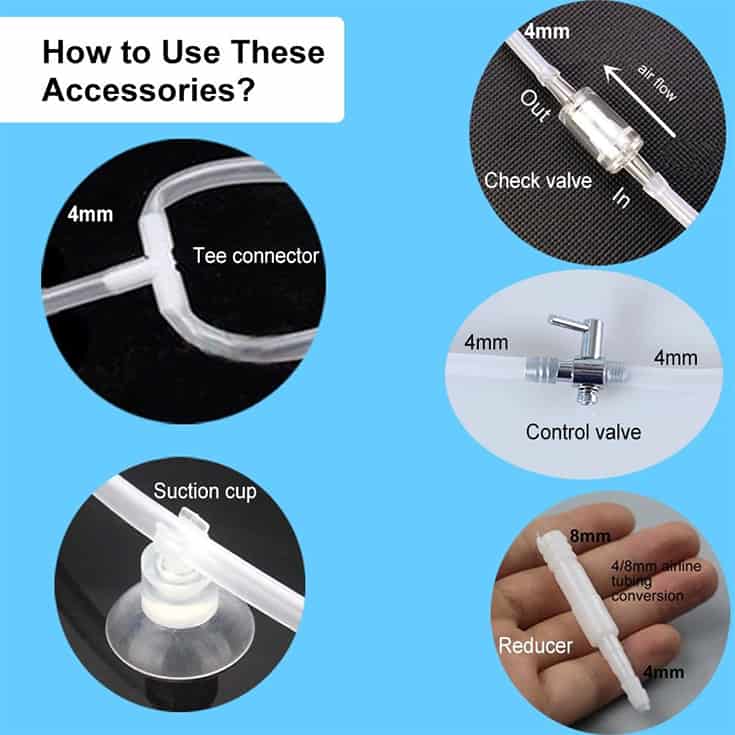
As you can see, there’s a wide world of aquarium air stones out there, and it isn’t always easy to identify the perfect product for your tank. What should you consider as you’re shopping for your aquatic aerator, and how do you install and care for one?
How To Pick The Best Type Of Air Stone For Your Tank
With six distinct types and hundreds of unique products, how can you narrow down the list of air stones to find the best option for your tank? It depends on your priorities, budget and aquarium set-up.
Efficiency vs Appearance
First, ask yourself if you need a highly efficient air stone or whether you’re just looking to add some fun and excitement to your tank. Just as with CO2 diffusers, air stones that produce consistent, tiny bubbles are better and more efficient at O2 delivery than those that are erratic or make big bubbles.
Size, Shape And Location
Also consider your tank set-up and the type of animals that live inside. If you have fish like Bettas that don’t like swimming in currents, be sure your bubbler’s placement won’t disturb them. Don’t put bubblers too close to your filter intakes or directly under the outflow since that would just scatter the bubbles.
Consider The Long Term Expense

If you need an efficient air stone to oxygenate and circulate your water, then it’s best to get a premium air stone or bubble wall and be ready to replace it every 3 to 6 months. Classic air stones are usually the least expensive option and can be rehabbed as well if you don’t mind taking the time to do it.
How Do You Install An Air Stone In Your Tank?
Do air stones need a pump? Yes, you’ll need an inexpensive aquarium pump and a length of clear plastic tubing to force air through your air stone or bubbling device, but they are not hard to set up in your tank:
- Soak the stone or bubbler in a bucket of your aquarium water for 24 hours to ensure it’s completely saturated.
- Don’t skip this step, or your device may not bubble properly.
- Attach the thin plastic air tubing to the hollow connector on the stone and secure the bubbler low in your aquarium (close to the substrate or slightly underneath it) with a suction cup or weight.
- Run the air tubing and any other cords out the top of the aquarium, add a check-valve to prevent water from back flowing down line to your pump, and connect the tubing to the air pump’s connector.
- Plug-in the air pump and plug in any additional electrical cords and things should start right up!
How Do You Clean An Air Stone?

The microscopic holes in air stones and diffusers can get clogged over time with biofilm, and it’s not uncommon for algae to grow on the surface and further obstruct the bubbles. Here are my tips for cleaning and maintaining your aquarium aerator.
Clean Diffusers And Bubbling Ornaments Monthly
You’ll want to remove and gently clean your bubbler every month or two, especially if their performance starts to wane. Carefully remove algae from the diffuser’s bubble tube with a brush or scrubber and rinse well in a bucket of your aquarium water. You can also scrub algae and biofilm from bubbling ornaments this way.
Scrub Air Stones Monthly And Rehab Or Replace As Needed
I scrub and rinse my air stones every month, just as I describe for the diffusers and bubbling ornaments, but even with cleaning, there’s a noticeable drop in performance by the second or third month. It’s usually recommended that air stones get replaced entirely every 3 months, or about 4 times a year.
Natural air stones can actually be rehabbed, although the process is time-consuming and requires soaking the stone in a dilute bleach solution and air drying. While some aquarists also attempt to rehab plastic diffusers this way, I find bleach causes the plastic and rubber parts to become brittle. It’s better to just replace them.
Top 5 Air Stones For Aquarium Reviews

While there are hundreds of aquarium air stones, diffusers and bubbling ornaments to choose between, we’ve searched out some of the best options on the internet in terms of price, quality and reliability. Whether you want an air stone for a 10-gallon aquarium or the best aquarium bubble wall, we’ve got you covered!
1. Aqua Fizzzz Cylinder Air Stone

- Type: Classic Air Stone
- Dimensions: 1.5 inches tall
- Includes: 4 air stones
If you’re looking for a small air stone for your Nano tank, box filter, or sump system, these inexpensive and high-quality air stones from Aqua Fizzzz could be the aerator for you! Made from a durable pumice-like stone, these classic air stones are ideal for a host of applications. The small cylinders fit easily inside most riser tubes and connect up with the standard-sized aquarium air tubing. You’ll have to supply the tubing and pump, but these simple air stones don’t require an especially powerful air pump to produce a cascade of tiny bubbles.
These stones come in a pack of two, so you can use them simultaneously for a larger tank or hold one back as a replacement. While the stone itself is high quality, sometimes the hollow connector can come loose and allow air to escape from the base. You may need to glue it in place with a bit of silicone, especially after cleaning or rehabbing. They aren’t the most attractive bubblers on the list, but in terms of price and performance, they are an excellent budget option!
| Benefits | Disadvantages |
|---|---|
|
|
2. Imagitarium Bubbling Column Airstone

- Type: Classic Air Stone
- Dimensions: 1 inch tall
- Includes: 4 air stones
If you’d like to pick up several aerators at a time, this four-pack of black air stones from Imagitarium might be the way to go. At 1-inch in height, these stones are ideal for smaller tanks and for use in filters and sump systems. The matte-black colored stones aren’t especially attractive, but they’re easier to hide in your tank than white air stones and show less discoloration as they age. I’d go with black stones over white if I had a choice.
These air stones work with the standard plastic tubing and air pumps, so you won’t have to splash out for special equipment to use them. The quality may vary from stone to stone, however, so you may see better performance and smaller bubbles with some stones in your multipack. They are fairly lightweight as well and often need to be anchored in place at the bottom of your tank. If you’re looking for a deal and want to buy a bunch of replacements at once, this could be the ideal option for you.
| Benefits | Disadvantages |
|---|---|
|
|
3. Hygger Aquarium Air Stone Kit

- Type: Bubbler Ornament
- Dimensions: 5.2 inches in diameter
- Includes: 4-inch air stone disk with a weighted base, control valve, suction cups, check valve, t-connector, reducer
While most bubbling ornaments are attractive but not very efficient at diffusing O2 into your aquarium water, this lovely bubbling disk from Hygger is a notable exception. This is definitely my favorite bubbler on the list and the product I’d choose for tanks over 20-gallons. This kit even comes with protective parts, including control and check valves. All you’ll need to add is the air tubing and a strong air pump, and you’ll have a beautiful stream of microbubbles rising in your tank!
Since the weighted bubbling disk is 5-inches in diameter, it’s probably oversized for Nano tanks, but would be a perfect addition to larger aquariums. It’s very attractive and easy to secure in your tank, but it does have a few downsides. The bubble disk is so fine you may need a stronger air pump to push the air through, especially in deeper tanks. Also, it doesn’t use the standard air tubing, so you’ll have to buy special 8mm tubing to connect it to your pump. Those problems aside, this is a beautiful diffuser and a great choice for many set-ups!
| Benefits | Disadvantages |
|---|---|
|
|
4. Aqueon Flex LED Aquarium Bubble Wand

- Type: LED Bubble Wand
- Dimensions: 8.13 x 2.95 x 2.25 inches
- Includes: Flexible bubble wand with 8 Blue LEDs
The Aqueon Flex is a hybrid diffuser that’s a bit challenging to place in any specific category. It’s a flexible bubble wand with deep blue LEDs, so you can wind it around your plants and decor for a custom appearance or use it as a wall of lights and bubbles at the back of your tank. This model is the perfect size for tanks 10-gallons and up, and there are smaller sizes available as well.
Like many bubble wands, however, the Aqueon isn’t the most efficient at diffusing O2. The flexible plastic bubble tube has regularly spaced holes and produces large bubbles instead of tiny ones. The LEDs don’t last very long and are not replaceable, and the entire bubbler isn’t very durable. The most annoying thing is you can’t switch off the LEDs at night, so if it’s in a bedroom you may need to unplug them instead. Still, it’s a very attractive diffuser and adds a lot of sparkle to your tank while it lasts!
| Benefits | Disadvantages |
|---|---|
|
|
5. JZMYXA Air Stones

- Type: Classic Air Stone
- Dimensions: 0.98 x 0.39 inch
- Includes: 10 air stones
Sometimes it’s easiest to buy an inexpensive multipack of air stones so you’ll always have spares on-hand. This 10-pack of basic white air stones from JZMYXA is a good way to go if you’d like to buy them in bulk. The tough corundum stone produces a steady fine stream of bubbles and is very durable. You won’t have to worry about these air stones chipping or wearing down.
These small stones are just under an inch in length and are very narrow, making them a good option for aerating lift tubes, sump systems, and breeding tanks of fish or shrimp. The stones themselves are quite good quality, but the overall construction is lacking. You may find that the hollow connectors slip out of place and have to be secured with silicone. Still, if you prefer to stock up on stones these are a solid option, even if they aren’t the most attractive. They are a great choice if you plan to rehab and reuse your stones because the corundum is so long-lasting and durable.
| Benefits | Disadvantages |
|---|---|
|
|
Conclusion
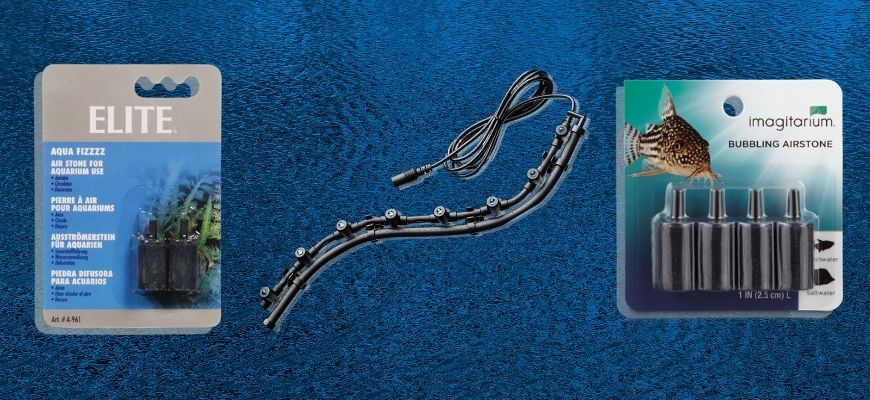
Air stones and aquarium air diffusers are one of the easiest ways to add interest to your tank while increasing the health of your fish and plants. You’ll have a lot of options when shopping for bubbling air stones, walls, wands and ornaments, and the best pick for your tank just depends on your needs and set-up.
I’d definitely go with the Hygger kit for larger aquariums, as it’s both the most attractive and most efficient at diffusing O2 into your water. If you prefer a classic air stone, the black 4-pack from Imagitarium is a discrete option, or you could opt for the high-quality stones from Aqua Fizzzz. Tell us about your pick in the comments!
